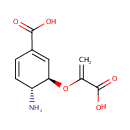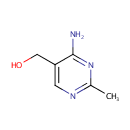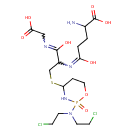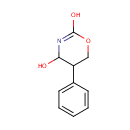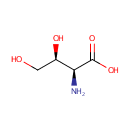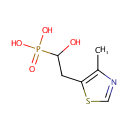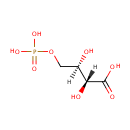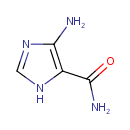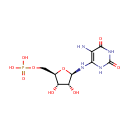
Search Results for compounds
Searching compounds for
returned 4373 results.
4-Amino-4-deoxychorismate (PAMDB000933)
IUPAC:
(3R,4R)-4-amino-3-[(1-carboxyeth-1-en-1-yl)oxy]cyclohexa-1,5-diene-1-carboxylic acid
CAS: 133442-18-9
Description: 4-amino-4-deoxychorismate (or ADC) can be classified as a member of the Dicarboxylic Acids and Derivatives. These are organic compounds containing exactly two carboxylic acid groups. ADC is involved in antibiotic biosynthesis. In some antibiotic producers, p-aminobenzoic acid (PABA) or its immediate precursor, 4-amino-4-deoxychorismate (ADC), is involved in primary metabolism and antibiotic biosynthesis. (PMID 19389784) In Pseudomonas aeruginosa, the production of PABA is catalyzed by the PabC protein, a beta-lyase that converts 4-amino-4-deoxychorismate (ADC)--the reaction product of the PabA and PabB enzymes--to PABA and pyruvate. (PMID 15500462) 4-Amino-4-deoxychorismate lyase (ADCL) is a member of the fold-type IV of PLP dependent enzymes that converts 4-amino-4-deoxychorismate (ADC) to p-aminobenzoate and pyruvate. (PMID 10876155)
4-Amino-5-hydroxymethyl-2-methylpyrimidine (PAMDB000934)
IUPAC:
(4-amino-2-methylpyrimidin-5-yl)methanol
CAS: 73-67-6
Description: 4-amino-5-hydroxymethyl-2-methylpyrimidine is a member of the chemical class known as Pyrimidines and Pyrimidine Derivatives. These are compounds containing a pyrimidne ring, which is a six-member aromatic heterocycle which consists of two nitrogen atoms (at positions 1 and 3) and four carbon atoms. The conversion of 5-aminoimidazole ribonucleotide (AIR) into 4-amino-2-methyl-5-hydroxymethylpyrimidine (HMP) is a fascinating reaction on the thiamin biosynthetic pathway in bacteria and is probably the most complex unresolved rearrangement in primary metabolism. (PMID 15326535)
4-Glutathionyl cyclophosphamide (PAMDB000936)
IUPAC:
2-amino-4-{[2-({2-[bis(2-chloroethyl)amino]-2-oxo-1,3,2???oxazaphosphinan-4-yl}sulfanyl)-1-[(carboxymethyl)-C-hydroxycarbonimidoyl]ethyl]-C-hydroxycarbonimidoyl}butanoic acid
CAS: Not Available
Description: 4-glutathionyl cyclophosphamide belongs to the class of Peptides. These are compounds containing an amide derived from two or more amino carboxylic acid molecules (the same or different) by formation of a covalent bond from the carbonyl carbon of one to the nitrogen atom of another. (inferred from compound structure)
4-Hydroxy-5-phenyltetrahydro-1,3-oxazin-2-one (PAMDB000939)
IUPAC:
5-phenyl-5,6-dihydro-4H-1,3-oxazine-2,4-diol
CAS: Not Available
Description: 4-hydroxy-5-phenyltetrahydro-1,3-oxazin-2-one belongs to the class of Aromatic Homomonocyclic Compounds. These are aromatic compounds containig only one ring, which is homocyclic. (inferred from compound structure)
4-Hydroxy-L-threonine (PAMDB000940)
IUPAC:
(2S,3S)-2-amino-3,4-dihydroxybutanoic acid
CAS: 21768-45-6
Description: 4-hydroxy-L-threonine is a member of the chemical class known as Alpha Amino Acids and Derivatives. These are amino acids in which the amino group is attached to the carbon atom immediately adjacent to the carboxylate group (alpha carbon).4-hydroxyl-L-threonine is involved in pyridoxine biosynthesis. This result is consistent with a model in which 4-phospho-hydroxy-L-threonine (synonym, 3-hydroxyhomoserine phosphate), rather than 4-hydroxy-L-threonine, is an obligatory intermediate in pyridoxal 5'-phosphate biosynthesis. (PMID 8595869)
4-Methyl-5-(2-phosphoethyl)-thiazole (PAMDB000942)
IUPAC:
[1-hydroxy-2-(4-methyl-1,3-thiazol-5-yl)ethyl]phosphonic acid
CAS: Not Available
Description: 4-methyl-5-(2-phosphoethyl)-thiazole is a member of the chemical class known as Organophosphate Esters. These are organic compounds containing phosphoric acid ester functional group.
4-Phospho-D-erythronate (PAMDB000943)
IUPAC:
(2R,3R)-2,3-dihydroxy-4-(phosphonooxy)butanoic acid
CAS: Not Available
Description: 4-phospho-D-erythronate is a member of the chemical class known as Beta Hydroxy Acids and Derivatives. These are compounds containing a carboxylic acid substituted with a hydroxyl group on the C3 carbon atom. To establish a possible role of E4PDH in pyridoxal 5'-phosphate biosynthesis, we showed that 4-phosphoerythronate is a likely substrate for the 2-hydroxy-acid dehydrogenase encoded by the pdxB gene. (PMID 7751290)
4,5-Dihydro-4-hydroxy-5-S-glutathionyl-benzo[a]pyrene (PAMDB000944)
IUPAC:
(2S)-2-amino-4-{[(1R)-1-[(carboxymethyl)-C-hydroxycarbonimidoyl]-2-({11-hydroxypentacyclo[10.6.2.0?,??0?????0??????icosa-1(19),2,4,6,8,12,14,16(20),17-nonaen-10-yl}sulfanyl)ethyl]-C-hydroxycarbonimidoyl}butanoic acid
CAS: Not Available
Description: 4,5-dihydro-4-hydroxy-5-s-glutathionyl-benzo[a]pyrene is a member of the chemical class known as Peptides. These are compounds containing an amide derived from two or more amino carboxylic acid molecules (the same or different) by formation of a covalent bond from the carbonyl carbon of one to the nitrogen atom of another. 3-amino-2-propanol is invovled in L-threonine metabolism. D-1-Amino-2-propanol:NAD+ oxidoreductase activity, which catalyzes the second step in a pathway wherein L-threonine is converted to D-1-amino-2-propanol via the intermediate formation of aminoacetone, has been purified 500-fold from Pseudomonas aeruginosa.
5-Amino-4-imidazolecarboxyamide (PAMDB000946)
IUPAC:
4-amino-1H-imidazole-5-carboxamide
CAS: 72-40-2
Description: 5-Amino-4-imidazolecarboxyamide is a metabolite of purine metabolism. Adenine phosphoribosyltransferase [EC:2.4.2.7] catalyzes both the formation of 5-Amino-4-imidazolecarboxyamide and its conversion to 1-(5'-Phosphoribosyl)-5-amino-4-imidazolecarboxamide, also called AICAR. (KEGG)
5-Amino-6-(5'-phosphoribosylamino)uracil (PAMDB000947)
IUPAC:
{[(2R,3S,4R,5R)-5-[(5-amino-2,6-dioxo-1,2,3,6-tetrahydropyrimidin-4-yl)amino]-3,4-dihydroxyoxolan-2-yl]methoxy}phosphonic acid
CAS: Not Available
Description: 5-amino-6-(5'-phosphoribosylamino)uracil is a member of the chemical class known as Pentoses. These are monosaccharides in which the carbohydrate moiety contains five carbon atoms.
